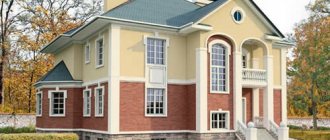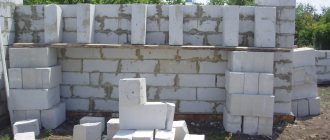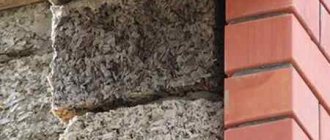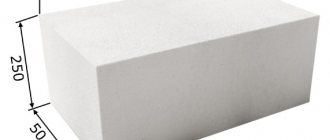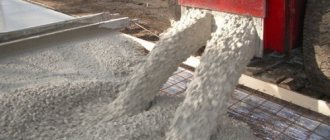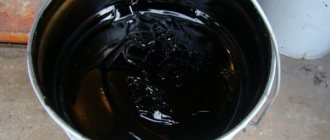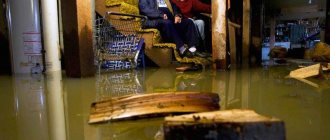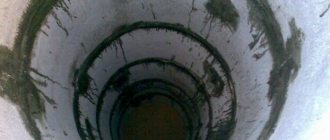Distinctive characteristics of a foundation made of FBS blocks
Products made industrially from high-strength concrete are characterized by stable geometry, good water resistance and compressive strength. The main raw materials for reinforced concrete blocks are granite crushed stone with an acceptable level of background radiation and river sand without clay. This provides the material with frost resistance.
A prefabricated foundation consisting of large blocks cannot be reinforced using traditional methods - rods and meshes bend under the weight of the slabs. The lack of stabilization of FBS leads to their deformation and the appearance of cracks. The voids between the blocks become a source of penetration of groundwater and storm water into the structure.
Causes of leaks and flooding of basements
The walls and other surfaces of the basement floors become damp, and the premises are subject to flooding due to violations of construction technology: the lack of a drainage system, roll waterproofing of the foundation base and ventilation ducts. Leaks occur due to the proximity of the groundwater facility to the walls.
Flooding of a FBS basement occurs when one of the construction stages is skipped: preliminary compaction of sand and crushed stone in a dug pit with a vibrating plate, filling the voids between reinforced concrete slabs with concrete. After installing the blocks, it is often necessary to create an armored belt on top of them under the Mauerlat and ceilings. Technological requirements include mandatory waterproofing of the foundation in case of high groundwater levels at the construction site.
What do we offer?
Stargidrostroy company offers a whole range of waterproofing services. We have been working in this direction for several years now and have been successfully cooperating with individuals, commercial and government organizations. You can contact us at any stage of construction work, as well as to eliminate leaks at objects that are in operation. After you send us an application, our specialist will come to you, who will inspect the object and draw up a technical report on its condition. He will offer the best solution to the problem and advise you on all issues of interest.
Ways to troubleshoot problems. Advantages of using the injection method
Injection waterproofing of basements of buildings, industrial enterprises and other structures is carried out as a preventive measure to prevent leaks, eliminates dampness and moisture that penetrates into the premises through the joints of foundation slabs or at the points where utility lines enter.
Waterproofing of a block foundation, injection of special mixtures for treating seams, wall joints and voids, is carried out without restrictions regarding their location on the surface - horizontal or vertical. The liquid form and high viscosity of protective compounds make it possible to treat hard-to-reach places and guarantee their penetration deep into building materials. This effect is achieved incl. due to the presence of viscosity comparable to the fluidity of water, acrylate gels.
Waterproofing of FBS blocks by injection is carried out using the latest generation mixtures. Resins and gels produced using innovative technologies make it possible to process the foundation without dismantling its elements. The chemical resistance and strength of the created protective screens reliably isolate basements from the penetration of melt, ground and storm water.
WATERPROOFING INTERBLOCK JOINTS OF FBS BLOCKS
PROTECTING JOINTS FROM LEAKS IN CONCRETE STRUCTURES IS ONE OF THE MOST IMPORTANT ISSUES WHEN INSTALLING WATERPROOFING, BECAUSE THE MAIN PART OF LEAKS ACCOUNT TO THIS ELEMENT OF THE CONSTRUCTION. In this section we will look at the most common problems. The first step is to find out the exact distance of the edges of the blocks. Using PENETRON-PENECRIT technology It is important to knock out the interblock seam from block to block to a depth of at least 25mm with a jackhammer or a hammer drill with a 25mm spade. The locking layer of the Penecrit suture material is at least 25mm, because This layer will subsequently retain water. After dismantling the mortar from the interblock joints, we proceed to thoroughly grinding the concrete surface itself, the inner and outer surfaces of the joints of an angle grinder with a diamond cup. It is important to remove all remaining mortar and get down to structurally sound concrete. All loose areas, as well as areas of poorly vibrated concrete, are removed for the purpose of further restoration. The inner part of the seam and the heat-affected zone are thoroughly dust-free and moistened until saturated with an aqueous solution using a Karcher-type high-pressure apparatus. A solution of PENETRON is prepared in a proportion of 1 kg of dry mixture per 400 ml of water. We treat the internal cut of the seam and the heat-affected area with penetrating waterproofing material Penetron using a brush with synthetic bristles. After processing the seam, wait about 40 minutes until the material sets to the surface. We prepare the suture waterproofing material Penecrit in the proportion of 1 kg of dry mixture per 20 ml of aqueous solution. Important! pour water into the dry solution, not vice versa, to avoid the formation of lumps. The master waterproofer puts on a chemical. resistant rubber gloves (we use medical Dermagrip high risk examination gloves). The hole is filled with Penecrit suture material. After the material has set (with temperature deviations, the time is 30-60 minutes), prepare a solution of the penetrating waterproofing material Penetron. We process the surface of the seam and the heat-affected area. Care of the treated surface for 5-7 days by spraying an aqueous solution in the “smoke” mode, covering with plastic film. This technology allows you to achieve a 100% waterproofing effect. This material has a service life of up to 50 years (for the entire service life of the concrete structure), while other types of materials will serve you: roll wrapping for 5-7 years, membrane up to 10 years, liquid rubber up to 15 years. Our technology using the Penetron system allows us to carry out waterproofing work on any side of the structure. If you don't have plaster finishing, etc. in your basement yet. , or of course you feel sorry, but it’s easier to carry out dismantling work and install waterproofing from the inside, we are ready to help you with this. If high-quality expensive repairs have already been made inside the premises and there is no blind area on the street yet, it is possible to dig out the foundation to the main slab, then we will be happy to perform this type of work from the outside of the structure. Remember that each material has its own service life. Waterproofing in this case is no exception. Your decision is to break the blind area every 5 years, dig up the foundation, dismantle the old waterproofing, install a new one, import clay, make a clay castle, tamp, lay horizontal waterproofing, pour sand and crushed stone, pour a new blind area, put the curb stone in place, etc. This is the cost of new materials and the cost of work. Or contact a specialized company once, which will not only do its job efficiently, but will also provide you with a guarantee for all types of work performed. Sincerely yours POSEIDON.
Materials and technologies
Polyurethane resins, which are used for waterproofing building structures made from FBS blocks, are two-component materials with high rates of adhesion and elasticity. When in contact with liquid media, the mixture increases in volume up to 20 times, demonstrating water resistance at pressure levels of 2 MPa and above.
Injection waterproofing of foundation blocks with resins is carried out in several stages:
- determining the location of the leak;
- drilling holes in concrete at an angle of 45 degrees;
- installation of discharge pipes into grooves;
- filling seams or cracks with polyurethane foam under pressure of 150 atm to stop water flows;
- injection of polyurethane resin into the cavity;
- checking for leaks;
- dismantling of equipment;
- sealing the created holes.
Using polyurethane mixtures in basements, cracks of a minimum size, from 0.1 mm, are isolated by displacing moisture from voids and filling with resin. The created monolithic water barrier is characterized by high resistance to chemical media, strong adhesion to concrete surfaces and durability - service life up to 100 years.
Waterproofing a block foundation and basement with acrylate gels allows you to fill not only the cavities inside the walls, ceiling or floor with the material, but also the space around the seams. The technology of injecting the mixture under pressure is in many ways similar to the treatment of leaks with polyurethane resins.
There are several methods for carrying out work to insulate the foundation and basement from moisture with acrylate gels:
- volumetric - used for preserving structures buried in the ground without losing their vapor-permeable properties and pre-excavating elements;
- cut-off - creating an anti-capillary curtain between the walls of the building and the foundation blocks;
- veil - organization of a protective membrane between the soil and elements of the building structure to protect against dampness and damage to the material due to water penetration.
The technology of processing with acrylate gels has proven itself to be excellent in repairing expansion joints and treating foundations at the joints of FBS blocks. In the presence of pressure leaks, the protective screen can withstand water pressure of up to 2 barrels.
Horizontal waterproofing
A monolithic or strip foundation made of FBS blocks can be protected from moisture using the horizontal method. To do this, waterproofing material is laid at a level of 10 cm above or below the future level of the basement floor. The joints between the horizontal base and the walls must be well insulated. It is important that water does not flow under the base of the foundation slabs.
Work on waterproofing the floor from FBS blocks is carried out in this way:
- The bottom of the pit is filled with clay and then compacted.
- Afterwards, the surface is poured with concrete, which after 10 days must be carefully treated with mastic.
- Roofing material is laid out on the mastic layer, after which it is again lubricated with mastic. The second layer provides maximum protection; roofing felt is laid with an overlap.
- It must be filled with concrete mixture, and then the ironing operation must be performed. It is required to pour pre-sifted cement onto the concrete 2 hours after pouring and level it. When this layer gets wet, it is necessary to carry out further work, as with a regular concrete screed.
To insulate a strip foundation, it is necessary to lay a layer of bitumen-based mastic on top of the strip, and then lay roofing felt.
FBS horizontal waterproofing scheme.
This coating is applied 2 times. Those edges of the roofing material that will hang on the sides must be carefully brought down, and then pressed down with material for vertical waterproofing of the foundation made of FBS blocks.
Performing such horizontal waterproofing assumes that the foundation will be additionally protected by a drainage system. When groundwater is too high, the soil is not permeable enough. It is for this purpose that preliminary calculations are carried out, which make it possible to determine the height of groundwater, soil type and other conditions.
Waterproofing a block foundation, i.e. external drainage, is carried out as follows:
- A trench is dug along the perimeter of the base structure; it should be located at a distance of 70 cm from the wall.
- The depth of the trench should be equal to the depth of groundwater, its width is taken to be 40 cm.
- It is necessary that the trench lies at a slight slope, this allows for natural removal of moisture from the foundation.
- Geotextiles are laid at the bottom, after which gravel is filled.
- To ensure moisture removal, drainage pipes are used; after laying them, the trench is filled with washed gravel to a depth of 20-30 cm, covered with the edges of geotextile.
- The last step is to fill it with soil that was previously removed during digging.
Advantages of injection waterproofing with resins and gels
Low viscosity up to 150 MPa of innovative materials for treating foundation leaks from FBS allows them to penetrate into all pores of the working surface. This provides protection from water even with subsequent deformation of the building structure and enlargement of the repaired cracks. Mixtures based on acrylates have increased tensile strength and retain their elasticity at sub-zero air temperatures.
Acrylate gels and polyurethane resins for insulation do not require pre-drying of the working surface of the foundation due to their high adhesion strength to dry and wet materials. One of the advantages created by the injection method of water barriers is their immunity to not only moisture, but also mold fungi. The use of innovative means for waterproofing FBS blocks is possible in a wide temperature range - from +3 °C to +40 °C.
Acrylate-based gels, which were used during the construction phase of the building, stabilize the soil adjacent to the structure and reduce shrinkage of the concrete foundation. Innovative materials make it possible to repair previously produced waterproofing of FBS blocks.
By phone you can get advice and call craftsmen, they will be able to assess the complexity of the work, calculate the estimate, and draw up an agreement for the performance of services.
Features of the use of FBS
When planning waterproofing of blocks, it is necessary to take into account the chemical composition and level of soil water. By interacting with particles of different nature, they are able to change their composition and concentration.
Waterproofing a foundation made of FBS blocks and their construction differs slightly from the cost of a solution intended for pouring a monolithic foundation. With FBS blocks there is no need to adjust to the weather.
There is also no need to construct formwork and reinforcing frames. Needless to say, all these processes are by no means easy. FBS blocks are absolutely in no way inferior to monolithic tape in terms of strength and water resistance (provided that all technological requirements have been met).
Naturally, a crane and associated costs for transporting the blocks themselves will be required, but the total cost will still be lower than the cost of concrete and reinforcement.
If the house was designed without a basement, horizontal waterproofing is used for FSB blocks.
